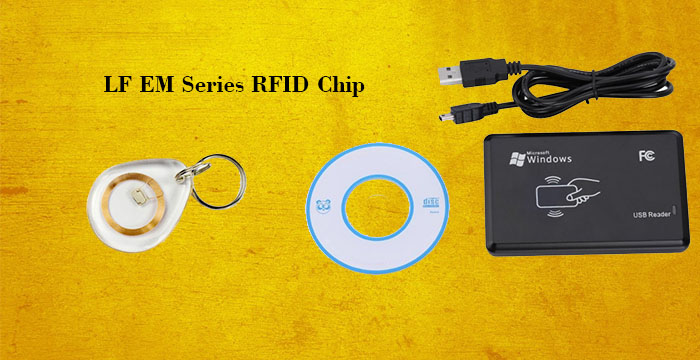EM series chips (EM4100, EM4200, and EM4305) are low-frequency (LF) chips manufactured by EM Microelectronics. They offer low-cost solutions for many applications, including access control and animal identification.
But how do you know which chip is right for your application? Choosing LF EM series Chip RFID can be a daunting task, but we’re here to help!
What is LF EM Series RFID Chip?
LF EM series RFID chips are passive RFID tags that transmit data using low-frequency (LF) electromagnetic waves. They work by inductively coupling to an LF reader, which generates a magnetic field that powers the tag.
The tag then uses this power to backscatter a signal to the reader. This signal contains the tag’s data, which the reader can decode. LF EM series RFID chips are very cost-effective and have numerous applications.
Why Use an LF EM Series RFID Chip?
In any business, considering the total cost of ownership (TCO) is essential to making smart decisions about technology investments. TCO takes into account not only the purchase price of a product but also the costs of operating and maintaining that product over its lifetime.
LF EM series chips offer a very attractive TCO because they are inexpensive to purchase. They also do not require a battery or other power source, making them easy to operate and maintain.
Additionally, these chips are versatile. They can be used for a wide range of applications, including animal identification and access control. This way, you do not need to purchase separate systems for each application.
Come scegliere il chip RFID della serie LF EM? EM4100? EM4200? O EM4305?
Now that you know the basics of LF EM series RFID chips, let’s take a closer look at the three most popular chips: EM4100, EM4200, and EM4305.
EM 4100
The EM4100 (previously H4100) is the most basic CMOS integrated circuit available from EM microelectronics. It is powered by an external coil that couples to the chip when it is in the magnetic field of an LF reader.
When it turns on/off the modulation current, this chip sends a 64-bit data string that can be read by the LF reader. This data is stored in a factory-programmed memory array.
The EM4100 is typically used in applications where only a unique identifier is needed, such as in access control systems. They consume very little power, making them super economical.
Features of EM4100
- 64-Bit Memory. These chips contain a factory pre-programmed 64-bit read-only memory (ROM) that stores a unique identification number. The programming occurs through intense laser fusing of polysilicon links. This memory cannot be changed or overwritten.
- Different Data Encoding Techniques. Data can be encoded in PSK (Phase Shift Keying), Machester, or Biphase.
- Operating Frequency. The EM4100 operates in the 100 – 150 kHz range
- Significantly Large Modulation Depth. These chips have a modulation depth that is significantly larger than most other LF chips. This is due to low impedance modulation.
- Di piccole dimensioni. These chips are very small, making them easy to integrate into a wide range of applications. They are also the best for implantation.
- On-Chip Resonance & Buffer Capacitor. The EM4100 has an on-chip resonance capacitor and buffer capacitor. This allows the chip to be used without an external capacitor, which reduces the overall size and cost of the system.
- On-Chip Voltage Limiter. The EM4100 has an on-chip voltage limiter, which protects the chip from damage due to excessive voltage.
Applications of EM4100
- Logistics Automation. The EM4100 can be used in logistics automation applications to track and manage inventory.
- Access Control Systems. The EM4100 is often used in access control systems, such as for controlling entry to a building or area. The data stored on the chip can be used to grant or deny access.
- Anticounterfeiting. The EM4100 can be used in products to help combat counterfeiting. The unique ID number stored on the chip can be used to track products and verify their authenticity.
- Industrial Transponder. The EM4100 is useful in industrial applications where RFID is used for identification and tracking purposes.
EM4200
The EM4200 is a CMOS integrated circuit used with electronic Read-Only RF transponders. It replaced the EM4102/EM4005/EM4104. Compared to its predecessors, it offers higher read ranges and a 250pF resonant capacitor on its coil terminals.
The EM4200 is powered by the magnetic field of an LF reader and can store a 128-bit data string that can be read by the LF reader. However, there are several other selectable options, including 64-bits and 96-bits ROM.
Additionally, these chips have different data rates & encoding options, including:
- Manchester 32 & 64 RF clocks/bit
- Biphase 32 & 64 RF clocks/bit
- PSK & 16 RF clocks/ bit
- FSK2 & 50 RF clocks/bit
This diversity in options allows you to tailor the chip to your specific application. This way, you can optimize performance and save on costs.
Features of EM4200
- 128-Bit Memory. These chips contain a factory pre-programmed 128-bit read-only memory (ROM) that stores a unique identification number. It also has options for 64-bits and 96-bits ROM.
- Lower Power Consumption & High Performance. The EM4200 has low power consumption and high performance. Additionally, it is backward compatible with the EM4005/4102.
- On-Chip Resonance Capacitors Integrated. The EM4200 has several capacitors, including 250pF, 75pF, and 0pF mask option. Additionally, you will not need external buffer capacitors.
- Operating Frequency. The EM4200 operates in the 100 – 150 kHz range.
- On-Chip Rectifier & Voltage Limiter. The EM4200 has an on-chip rectifier and voltage limiter. This ensures that the chip is protected from damage due to excessive voltage.
- -40°C to +85°C Temperature Range. You can use these chips in a wide range of temperatures, from -40°C to +85°C, making them suitable for a variety of applications.
Applications of EM4200
- Animal Identification. These chips are approved by ISO11785 (FDX-B) for animal identification.
- Waste Management (BDE). The EM4200 RFID chips are encoded with data that is used to track and manage waste bins.
- Logistics Automation. The EM4200 chips are used to increase efficiency and accuracy in logistics applications.
- Controllo di accesso. The EM4200 chips are in high-security access control systems. The data on the chip can be used to authenticate the user and grant or deny access.
- Product Identification & Authentication. The EM4200 chips are used in products to help combat counterfeiting. The data on the chip can be used to track products and verify their authenticity.
EM4305
The EM4305 is a CMOS integrated circuit used in electronic Read/Write RF transponders. It offers low-cost solutions for many applications that require Read/Write functionality, such as access control, animal identification, and asset tracking. It works 100% well with EM4469/4569 family.
The EM4305 is powered by a continuous 125 kHz magnetic field of an LF reader and can store 512-bit of EEPROM data that can be read and written by the LF reader. Usually, the data is organized into approximately 16 words of 32-bit each.
Features of EM4305
- Two Data Encoding Techniques. This chip uses two different data encoding techniques, Manchester and Biphase.
- High Security. The chips have a 32-bit password read/write protection that can be used to prevent unauthorized access. You can also invoke the lock feature to convert the tag into read-only.
- ISO 11784/11785 Compliant. These chips are compliant with the ISO 11784/11785 standards for animal identification.
- Operating Temperature Range. The chips can operate in a wide range of temperatures, from -40°C to +85°C.
- Multiple Data Rate. These chips have 64, 40, 32, 16, and 8 RF clocks per data bit.
- Two Resonant Capacitor Types. The chips have 250pF and 210pF resonant capacitors with mask options.
- Low Power Consumption. These chips are designed for low power consumption, ensuring fast activation by the reader.
- No Need for External Buffer Capacitor. These chips do not require an external buffer capacitor, which reduces the system cost.
- On-Chip Rectifier & Voltage Limiter. Due to the on-chip rectifier and voltage limiter, the chips cannot be damaged by excessive voltage.
Applications of EM4305
- Animal Identification. These chips are minute and can be injected into animals for easy identification and tracking.
- Controllo di accesso. The EM4305 chips are used in access control systems for both commercial and industrial applications.
- Pigeon Races Standardization. These chips are used to standardize pigeon races. The data on the chip can be used to track the pigeons and ensure that the race is fair.
- Waste Management (BDE). Managing waste is a huge problem faced by cities around the world. The data on these chips can be used to track waste bins and ensure that they are properly disposed of.
How to Choose LF EM Series RFID Chip?
If you need a chip with more memory, the EM4305 is a good choice. Additionally, this choice offers a Read/Write function, which can be useful for applications that require regular updates, such as access control or animal identification.
The EM4200 & EM4100 are Read-Only, which can be limiting if you need to update the data on the chip regularly. However, these chips have a lower price point and may be a better choice for applications that do not require regular updates.
Overall, the EM4100 is the least expensive but has the least amount of memory. You may want to avoid them unless your application does not require much data storage.
The EM4200 is a good middle-of-the-road choice, offering more memory than the EM4100 but not as much as the EM4305. However, the EM4200 is Read-Only, so you will not be able to update the data stored on the chip.
Articoli correlati
- Guida per principianti - Cos'è un tag NFC?
- Come acquistare i tag RFID - Una guida all'acquisto di tag RFID completa
- Scopra tutto sui diversi tipi di tag RFID
- Caratteristiche e vantaggi unici delle etichette RFID personalizzate
- La guida per principianti all'RFID
- What Are RFID Chips?
- Come scegliere un chip RFID MIFARE?
- What’s The Difference Between Ntag213, Ntag215, And Ntag216?


